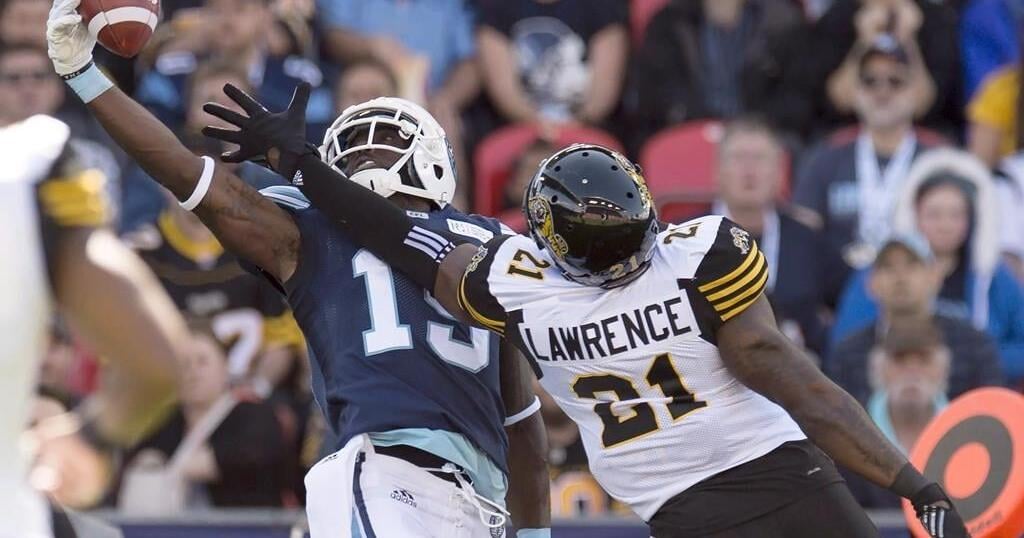For over a decade, S.J. Green was the enemy of Hamilton Tiger-Cats fans.
He should receive a warmer reception Saturday when recognized as a member of the Canadian Football Hall of Fame. Then again . . .
“I’ll be honest, if I get a boo or two I won’t be surprised,” Green said with a chuckle. “It’s fun, I’m looking forward to everything that comes with this weekend.”
Joining Green in the Class of 2024 are former players Chad Owens, Weston Dressler, Vince Goldsmith and Marvin Coleman. Former CFL coach Ray Jauch and amateur football icon Ed Laverty (posthumously) were named as builders.
The seven were scheduled to be formally inducted Friday night, and then honoured Saturday at halftime of the Hamilton-Ottawa game at Tim Hortons Field. Green now fully appreciates the magnitude of the honour.
“Being here and getting to see some of the other inductees has been the ground-breaking moment for me where it’s actually starting to set in, that it’s a real thing,” Green said. “To put it into the shortest phrase I can, it’s football eternity.
“Not everyone gets to play the game at a professional level … to be a part of this brotherhood and statistically elite group is amazing and very humbling.”
The six-foot-three, 216-pound Green was a fluid receiver with Montreal (2007-16) and Toronto (2017-19). Green, 39, registered 716 catches for 10,222 yards with 60 TDs.
He suffered a serious knee injury early in 2016 but registered career highs in catches (104) and yards (1,462) the next season with Toronto. The Argos would win the Grey Cup, Green’s third (2009-10 with Montreal).
Green’s pro career ended in the XFL in 2020 as the CFL didn’t play that season due to the global pandemic. However, Green’s contract was abruptly terminated when the league suspended operations.
He retired in 2022 after signing a one-day contract with Montreal. Green, who owns and operates a landscape business in Tampa, said his transition to life after football wasn’t seamless.
“I went through a period … I don’t want to call it depression but I don’t know what else to call it, where it was just hard to watch the CFL game,” Green said. “I felt like I didn’t get to end it how I truly wanted.
“I miss the game still to this day and it was hard to get over but eventually you grow up, right? This (induction) makes all the time worth it, it feels right.”
Green also appreciates being inducted with Owens. Both began their CFL careers as practice-roster players with Montreal.
“That makes it more special,” Green said. “We both came in from the perspective of being practice-squad guys, having to prove ourselves to get on the field.
“Unfortunately, Chad had to leave Montreal to show the league who he was as a player and person while I was able to stay in Montreal and reap the same benefits. To watch him go to Toronto and become the player he was made it all come full circle. It’s very rewarding to go in with Chad.”
The five-foot-eight, 180-pound Owens, dubbed The Flyin’ Hawaiian, spent 10 seasons with Montreal (2009), Toronto (2010-15), Hamilton (2016, 2018) and Saskatchewan (2017). He was a four-time all-star, the league’s top special-teams player (2010) and its outstanding performer (2012).
Owens, 42, claimed his first Grey Cup ring with Montreal. He earned a second with Toronto in 2012.
Owens recorded 521 career catches for 6,217 yards and 26 touchdowns. He also had 4,027 punt-returns yards (11-yard average, five TDs) and 5,479 kickoff-returns yards, amassing 16,698 combined yards.
Dressler, 39, played with Saskatchewan (2008-15) and Winnipeg (2016-18), registering 715 catches for 10,026 yards and 61 TDs. The five-foot-seven, 168-pound Bismarck, N.D., native was the CFL’s top rookie in ’08 and a two-time all-star who made two Grey Cup appearances, winning in ’13 in Regina with the Riders.
Goldsmith, 65, was a dominant defensive lineman with Saskatchewan (1981-83, 1988-90), Toronto (1984) and Calgary (1985-87). He was the CFL’s top rookie in 1981 with 17 sacks then posted a career-best 20 two years later.
Goldsmith had 10 or more sacks eight times and finished with 130.5 (eighth all-time). He won a Grey Cup in ’89 with Saskatchewan.
Coleman, 52, was another dual threat. The five-foot-nine, 170-pound cornerback played with Calgary (1994-2000) and Winnipeg (2001-03) and was a three-time league all-star with 28 interceptions (six return TDs) and 538 tackles.
Coleman stands fourth all-time in punt-return yards (5,211), seventh in kickoff-returns yards (11,545) and scored seven return TDs. He played in four Grey Cups, winning twice with Calgary.
Jauch, 86, played in the ’59 Rose Bowl as a running back with Iowa and was an AFL first-round pick by Buffalo, but opted for Winnipeg.
He suffered a career-ending torn Achilles in Winnipeg’s ’61 Grey Cup win over Hamilton. Jauch became Edmonton’s running back coach in 1966 before being promoted to head coach in 1970.
He served as head coach with Edmonton (1970-76), Winnipeg (1978-82) and Saskatchewan (1994-95). He recorded 127 regular-season wins (sixth all-time) and in ’75 led Edmonton to its first Grey Cup win since 1956.
Jauch was the 1980 CFL coach of the year.
Laverty served as president of the Ottawa Nepean touch football league from 1964 to 2015. He held a similar post with the Ontario Touch Football League for over 10 years and helped launch Touch Football Canada.
Laverty was inducted into the Ottawa Sports Hall of Fame in 2014.
This report by The Canadian Press was first published Sept. 13, 2024.




























